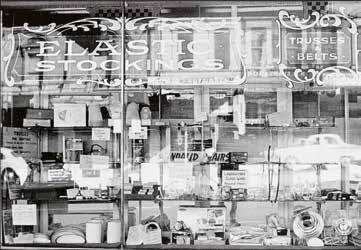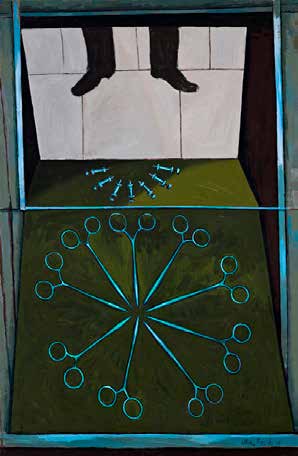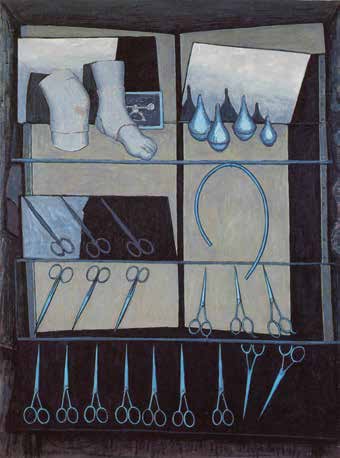ELASTIC STOCKINGS, 1965
JOHN BRACK
oil on canvas
130.0 x 96.0 cm
signed and dated lower right: John Brack 65
The collection of the artist
Deutscher Fine Art, Melbourne
The Reg Grundy AC OBE and Joy Chambers-Grundy Collection, acquired from the above in 1996
John Brack, Gallery A, Melbourne, 29 March – April 1965, cat. 6
John Brack, Gallery A, Sydney, 14 May 1965, cat. 4
John Brack and Fred Williams, Albert Hall, Canberra, 1 – 13 August 1967, cat. 7
John Brack: Selected Paintings 1947 – 1977, Royal Melbourne Institute of Technology, Melbourne, 15 March – 1 April 1977, cat. 21
John Brack: Retrospective: paintings and drawings, Australian National University, Canberra, 21 September – 16 November 1977, cat. 26
John Brack: A Retrospective Exhibition, National Gallery of Victoria, Melbourne, 11 December 1987 – 31 January 1988, cat. 67
John Brack, Selected Paintings 1950s – 1990s, Geelong Art Gallery, Geelong, 15 June 1996, cat. 8
John Brack Retrospective, National Gallery of Victoria, Melbourne, 24 April – 9 August 2009; Art Gallery of South Australia, Adelaide, 2 October 2009 – 31 January 2010 (label attached verso)
Brook, D., ‘Goths and venetians’, The Canberra Times, Canberra, 3 August 1967, p. 25
Millar, R., John Brack, Lansdowne Press, Melbourne, 1971, pl. 6, pp. 25, 35 (illus.), 52, 108
Grishin, S., John Brack Retrospective: Paintings and Drawings, 1945 – 1977, Australian National University, Canberra, 1977, pl. 26
Lindsay, R., John Brack: A Retrospective Exhibition, National Gallery of Victoria, Melbourne, 1987, pl. 67, pp. 55 (illus.), 122, 123, 130, 131, 140
Grishin, S., The Art of John Brack, Oxford University Press, Melbourne, 1990, vol. 1, pl. 26, pp. 97 (illus.), 99, vol. 2, cat. o145, pp. 20, 129 (illus.)
Grant, K., John Brack, National Gallery of Victoria, Melbourne, 2009, p. 138 (illus.)
Study for ‘Elastic Stockings’, 1964, watercolour, pen and ink on paper, 54.5 x 40.5 cm, private collection
1 brack.jpg

John Brack was appointed head of the National Gallery School in Melbourne in 1962 and over the following six years, he transformed it into a serious training ground for professional artists. The demands of the job meant reduced painting time, but he maintained a studio behind his office, undertaking a number of private commissions, as well as being represented in important exhibitions including Australian Painting at London’s Tate Gallery (1963) and Australian Painters 1964 – 66: The Harold Mertz Collection at the Corcoran Gallery of Art, Washington DC (1967). These years also saw the creation of the shop-window paintings, a series in which his stated aim to produce pictures which ‘operate on numerous levels of meaning [and]… have some reference to the complexity of life’1 was successfully achieved.
A number of Brack’s images relate to shops and shop window displays, and the first, made in 1955, depicts a display of commercial kitchen equipment he had seen at the top of Bourke Street in Melbourne. Simply titled, The Slicing Machine Shop, 1955 (private collection), it depicts gleaming meat slicers, measuring scales and giant mixers which assume threatening, anthropomorphic qualities belying their obviously inanimate status. Brack’s most concentrated series of shop window subjects emerged during the early 1960s, and
1 brack 2.jpg

this time, the windows featured in paintings such as Still Life with Self Portrait, 1963 (Art Gallery of South Australia) and The Happy Boy, 1964 (National Gallery of Australia) – the latter based on Roper’s medical supply shop in Swanston Street, Melbourne – displayed surgical instruments, prosthetic limbs and other medical aids. Bearing obvious associations with the human body, these objects enabled Brack to comment about life without depicting the figure, instead using subject matter that seemed to him, more appropriate for a contemporary artist.
Brack often found subjects walking the city streets and recorded the details of what he saw in quick sketches which were later used as aides memoire in the studio. Additional detail was sometimes provided by photographs taken by his friend Laurence Course, an art historian and keen photographer. Brack often incorporated his own reflection looking through the window, and the recognition that there were people inside the shop looking out, to add visual ambiguity and narrative complexity to these paintings. Summing this up, he said, ‘The exterior and the interior of the window become mixed up, they become a paradox… illustrative not simply of shop windows but of the whole aspect of life itself, so that people who pass by are entangled with the beautiful display, gleaming instruments… [which] have something to do with the props that hold people together.’2
The primary focus of Elastic Stockings, 1965 is an elaborate sign advertising said garments which dominates the top half of the image. The decorative, graphic qualities of the sign must have appealed to Brack, and luminous shades of yellow hint at the gold lettering of the original. Instead of depicting the window as he had encountered it, full of a myriad of practical items,3 his very singular vision and unique perspective of the world transformed what he saw, presenting a dramatic contrast between the showy signage and the lacklustre display of surgical instruments below. The result is humorous, but also somewhat melancholy. As he said, ‘What struck me is they had window displays [of surgical instruments] as you would display ladies’ dresses… to make them attractive… to attract… the passer by… to say ‘I will buy one’.4
This painting is classic Brack, exemplifying not only his great technical skill, but the distinctive intellectual ingenuity he brought to his art, and through which he created such a unique and significant place in the history of twentieth century Australian art. As Patrick McCaughey wrote, ‘His appeal is to the intelligence: to read what has been so clearly
1 brack 3.jpg

described. Yet behind the impersonal, unbroken surface lies a world which seethes with irony, ambiguity, where the normal is displaced or held in a different balance. The lucidity of Brack’s art, his subjects and his mode alike, do not disguise the complexity of his imagination.’5
1. John Brack interview, Australian Contemporary Art Archive, no. 1, Deakin University Media Production, 1980, transcript, p. 3
2. John Brack quoted in The Lively Arts: John Brack, ABC-TV documentary
3. See photograph by Laurence Course in Grant, K., John Brack, National Gallery of Victoria, Melbourne, 2009, p. 139
4. John Brack, Deakin University interview, op. cit., p. 6
5. McCaughey, P., ‘The Complexity of John Brack’ in Lindsay, R., John Brack, National Gallery of Victoria, Melbourne, 1987, p. 8
KIRSTY GRANT
